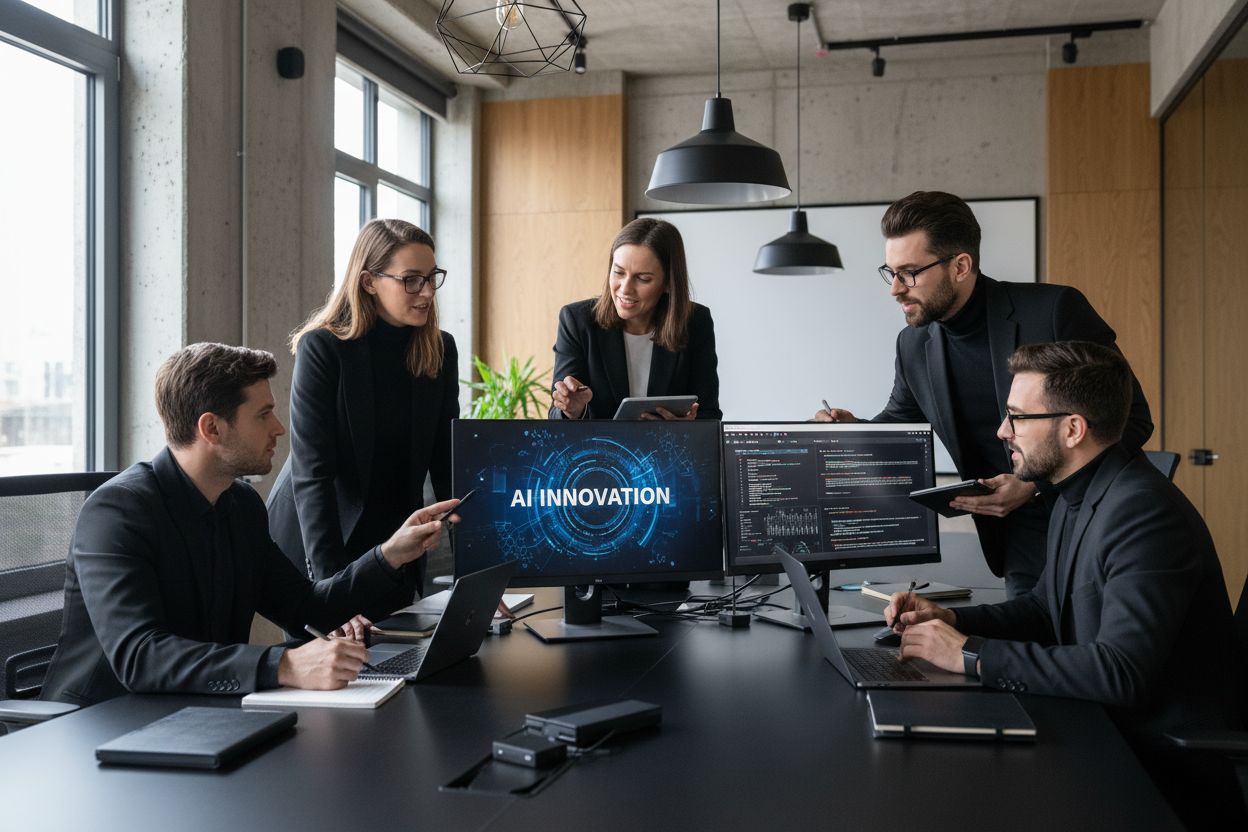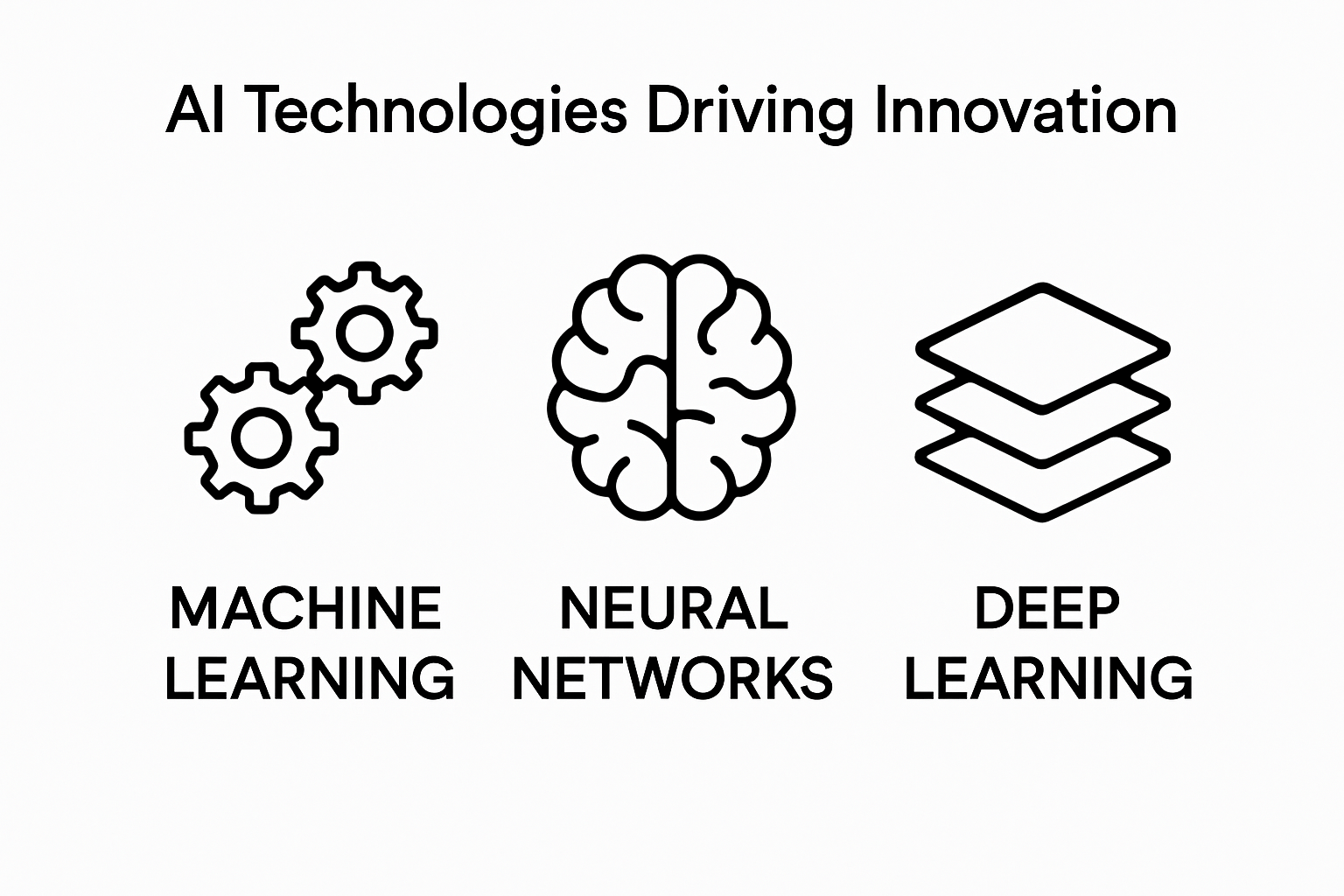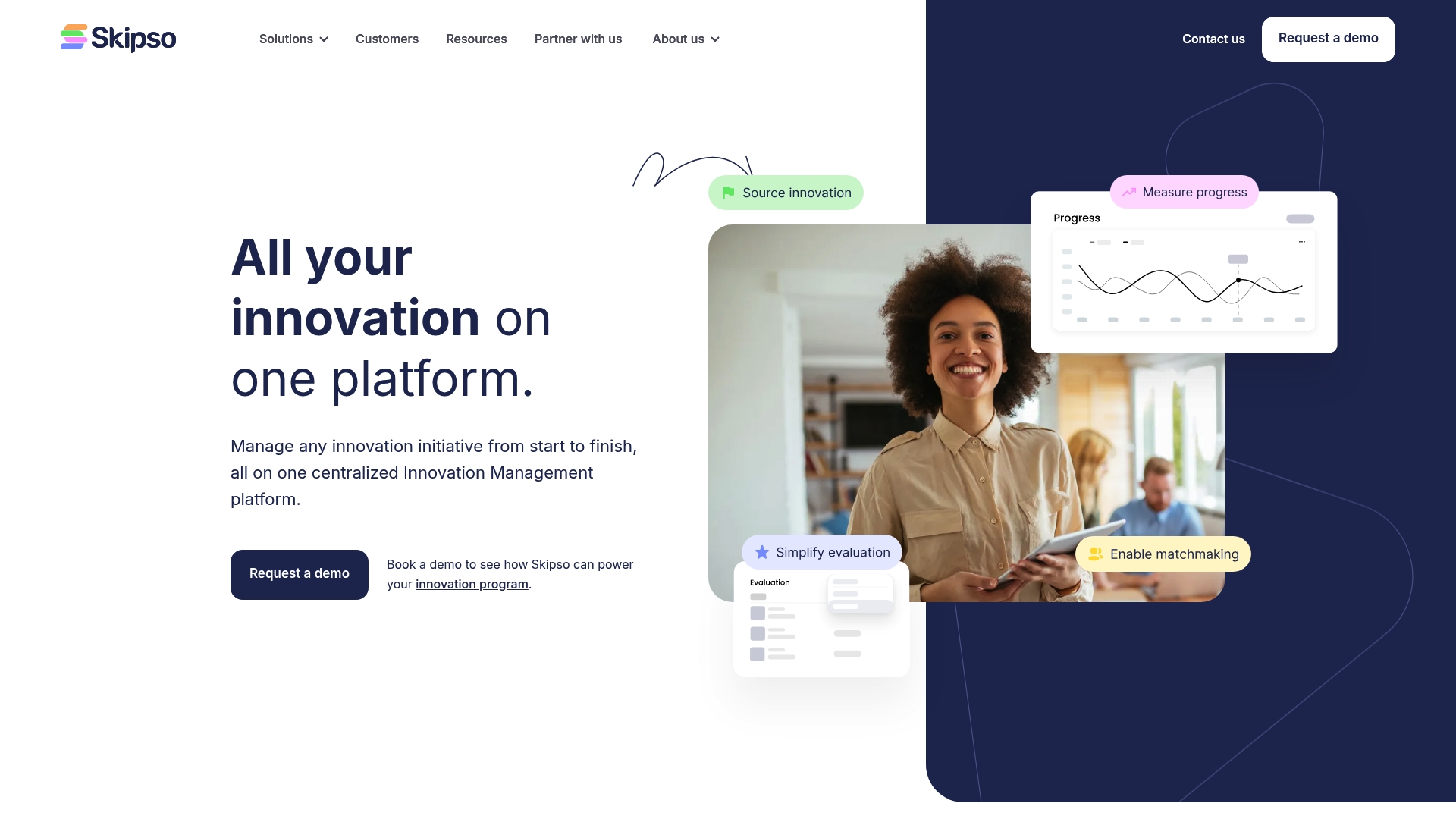


Understanding the Impact of AI on Innovation
AI is no longer just a sci-fi concept. Companies worldwide are now using it to reshape how innovation happens. Here is the surprising part. Recent Stanford research shows generative AI can produce thousands of unique ideas in just minutes. Most people worry machines might take over creative jobs. The twist is AI works best when it joins forces with humans, creating possibilities that neither could reach alone.
Table of Contents
- Defining Ai And Its Role In Innovation
- The Importance Of Ai In Driving Innovative Solutions
- How Ai Technologies Foster Creative Processes
- Key Concepts Behind Ai’s Influence On New Ideas
- Real-World Examples Of Ai Impacting Innovation
Quick Summary
| Takeaway | Explanation |
|---|---|
| AI accelerates innovation across industries | AI acts as a general-purpose technology, speeding up research and development processes in various sectors. |
| AI enhances decision-making through predictive models | By analyzing vast datasets, AI provides insights that help organizations make informed strategic decisions. |
| Generative AI supports creative ideation | Generative AI can produce numerous unique ideas quickly, expanding the possibilities for innovation teams. |
| AI optimizes resource allocation | AI enables organizations to allocate resources more efficiently, improving the effectiveness of innovation processes. |
| AI reveals hidden insights from data | By recognizing complex patterns, AI uncovers valuable insights that might be missed through traditional analysis. |
Defining AI and Its Role in Innovation
Artificial Intelligence (AI) represents a transformative technological paradigm that fundamentally reshapes how organizations approach innovation. At its core, AI is an advanced computational system capable of performing tasks that traditionally require human intelligence, such as learning, problem solving, pattern recognition, and decision making.
The Fundamental Architecture of AI
AI systems are built on complex algorithms and neural networks that enable machines to process vast amounts of data, recognize intricate patterns, and generate insights far beyond human cognitive capabilities. These systems leverage machine learning techniques that allow them to continuously improve their performance by analyzing and adapting from incoming data streams. Research from the OECD indicates that AI acts as a general-purpose technology accelerating innovation across multiple industry sectors.
Key technological components of AI include:
The following table summarizes the core components of AI architecture and their roles, helping readers quickly understand the building blocks that power AI-driven innovation.
| Component | Description |
|---|---|
| Machine Learning | Systems learn and improve from experience without explicit programming. |
| Neural Networks | Computational models mimicking the human brain for complex pattern recognition. |
| Deep Learning | Uses multilayered neural networks for more advanced learning and data abstraction tasks. |

- Machine Learning: Enables systems to learn and improve from experience without explicit programming
- Neural Networks: Computational models mimicking human brain structures for complex pattern recognition
- Deep Learning: Advanced machine learning technique using multilayered neural networks
AI’s Strategic Impact on Innovation Processes
In the innovation landscape, AI serves as a powerful catalyst that transforms traditional research and development methodologies. Organizations can now leverage AI to streamline ideation, predict market trends, optimize resource allocation, and rapidly prototype solutions. By processing enormous datasets and generating predictive models, AI empowers innovation teams to make more informed strategic decisions.
For those interested in exploring this topic further, read more about emerging innovation trends and how AI is reshaping organizational capabilities. The intersection of artificial intelligence and innovation represents not just a technological shift, but a fundamental reimagining of how breakthrough ideas are conceived, developed, and implemented across global industries.
The Importance of AI in Driving Innovative Solutions
Artificial Intelligence has emerged as a transformative force that fundamentally reimagines how organizations create and implement innovative solutions. Unlike traditional technological approaches, AI enables unprecedented capabilities for problem solving, pattern recognition, and strategic decision making across complex business landscapes.
Accelerating Research and Development
AI dramatically accelerates research and development processes by processing massive datasets exponentially faster than human researchers. According to McKinsey, AI helps organizations not only automate repetitive tasks but also explore entirely new frontiers in product and service creation. This computational power enables innovation teams to:
- Rapidly prototype and simulate complex scenarios
- Identify emerging market trends with unprecedented accuracy
- Predict potential technological breakthroughs
- Optimize resource allocation strategies
Strategic Innovation Enhancement
Beyond raw computational power, AI introduces strategic intelligence that transforms how organizations conceptualize and execute innovative solutions. By analyzing intricate relationships within data, AI systems can uncover hidden insights that human analysts might overlook. These insights become crucial for developing breakthrough technologies, designing more efficient processes, and creating competitive advantages.
For innovators seeking deeper understanding of technological trends, explore our comprehensive innovation report to gain advanced perspectives on AI driven innovation strategies. The integration of artificial intelligence represents more than a technological upgrade it signifies a fundamental reimagining of how organizations generate value, solve complex challenges, and create transformative solutions across industries.
How AI Technologies Foster Creative Processes
AI technologies are revolutionizing creative processes by introducing advanced computational capabilities that augment human creativity, challenge traditional thinking patterns, and generate novel solutions across multiple domains. These technologies do not replace human creativity but instead act as powerful collaborative tools that expand the boundaries of innovative thinking.
Generative AI and Creative Ideation
Generative AI platforms represent a breakthrough in supporting creative processes by producing original content, designs, and conceptual frameworks. Research from Stanford University reveals that these systems can generate thousands of unique ideas rapidly, providing innovation teams with a diverse range of potential solutions. By analyzing vast datasets and recognizing complex patterns, AI generates insights that human creators might not immediately perceive.
Key capabilities of AI in creative ideation include:
- Generating multiple conceptual variations simultaneously
- Breaking traditional cognitive constraints
- Identifying unexpected connections between disparate concepts
- Providing data driven inspiration for creative projects
Augmenting Human Creative Capabilities
AI technologies function as intelligent collaborators that enhance human creativity rather than replacing it. These systems can process complex information, simulate scenarios, and offer predictive insights that help creative professionals make more informed decisions. By handling computational and analytical tasks, AI frees human innovators to focus on higher order creative thinking and strategic problem solving.
For professionals interested in understanding how technological innovation transforms creative processes, explore our insights on building an innovation friendly culture. The synergy between human creativity and artificial intelligence represents a powerful paradigm shift in how breakthrough ideas are conceived, developed, and implemented across industries.
Key Concepts Behind AI’s Influence on New Ideas
Artificial Intelligence represents a sophisticated paradigm that fundamentally transforms how organizations conceptualize, generate, and validate innovative ideas. By introducing computational intelligence that transcends traditional human cognitive limitations, AI creates unprecedented opportunities for breakthrough thinking and strategic innovation.
Cognitive Amplification and Idea Generation
According to OECD research, AI accelerates knowledge generation and diffusion while facilitating complex idea recombination through advanced data analytics. This computational approach enables organizations to explore conceptual landscapes far beyond conventional human reasoning capabilities. AI systems accomplish this through:
- Analyzing massive interdisciplinary datasets
- Identifying non obvious connections between seemingly unrelated concepts
- Generating probabilistic scenarios and potential solution pathways
- Challenging established cognitive constraints and mental models
Predictive Insights and Pattern Recognition
AI technologies excel at recognizing intricate patterns within complex datasets, allowing innovation teams to uncover hidden insights that might remain invisible through traditional analytical methods. By processing multidimensional information rapidly, these systems can predict emerging trends, simulate potential outcomes, and provide data driven recommendations that significantly enhance creative decision making processes.
For professionals seeking deeper understanding of innovation dynamics, explore the nuanced difference between ideas and innovation to appreciate how AI transforms conceptual thinking. The integration of artificial intelligence represents more than technological advancement it signifies a fundamental reimagining of human creative potential, bridging computational intelligence with human imagination.
Real-World Examples of AI Impacting Innovation
Artificial Intelligence has transcended theoretical discussions and emerged as a tangible catalyst for transformative innovation across multiple industries. By providing sophisticated computational capabilities, AI enables organizations to solve complex challenges, develop groundbreaking solutions, and reimagine traditional operational paradigms.
This table compares how AI impacts innovation processes in two major sectors, highlighting the specific ways AI is transforming healthcare and manufacturing industries.
| Sector | Examples of AI-Driven Innovation |
|---|---|
| Healthcare | Accurate medical imaging, predicting disease progression, personalizing treatments, accelerating drug discovery |
| Manufacturing | Optimizing design, predictive maintenance, simulating design iterations, reducing development cycles |
Healthcare and Medical Research Innovation
According to IBM Watson Health, AI is revolutionizing medical innovation through unprecedented diagnostic and treatment capabilities. In healthcare, AI technologies are enabling remarkable advancements by:

- Interpreting complex medical imaging with remarkable precision
- Predicting potential disease progression
- Personalizing treatment protocols
- Accelerating pharmaceutical research and drug discovery processes
Manufacturing and Product Development Transformations
Manufacturing sectors are experiencing radical innovation through AI driven technologies that optimize design, production, and predictive maintenance processes. AI systems analyze massive datasets to identify inefficiencies, simulate potential design iterations, and recommend transformative improvements that traditional engineering approaches might overlook. These computational tools enable engineers to explore complex design scenarios rapidly, reducing development cycles and enhancing product performance.
For professionals eager to understand emerging technological trends, explore innovation horizons for 2024 and gain insights into how artificial intelligence continues to reshape industrial landscapes. The integration of AI represents more than technological evolution it signifies a fundamental reimagining of how organizations conceive, develop, and implement breakthrough solutions across diverse domains.
Ready to Turn AI Insights Into Real Innovation?
You have seen in this article how artificial intelligence unlocks creative potential and accelerates new discoveries, but real transformation often stops short when organizations lack the right structure to harness these breakthroughs. Managing complex data, aligning creative teams, and moving from ideation to implementation can be overwhelming without a scalable platform. Many leaders struggle to turn the predictive power of AI and data-driven innovation into measurable outcomes. This is where you can bridge the gap.

Skipso provides the infrastructure you need to not only manage cutting-edge innovation but to fuel it. Build on everything you have learned about AI’s impact by launching corporate innovation challenges, accelerating research, and truly maximizing your data-driven potential in one powerful platform. Visit Skipso to see how our solutions make the most of AI-powered innovation management. If you are curious about the future and want more insight into emerging innovation trends, do not miss our future of innovation report. Ready to make an immediate impact? Start now and see how your organization can stay ahead of the curve with Skipso.
Frequently Asked Questions
What is the role of AI in driving innovation?
AI serves as a catalyst for innovation by enhancing research and development processes, allowing organizations to streamline operations and make data-driven decisions, ultimately leading to the creation of groundbreaking solutions.
How does AI accelerate research and development?
AI accelerates research and development by processing large datasets rapidly, automating repetitive tasks, and identifying emerging market trends, which allows innovation teams to prototype and simulate scenarios more efficiently.
What is generative AI and how does it contribute to creativity?
Generative AI refers to innovative platforms that produce original content and ideas. It aids creative teams by generating diverse conceptual variations and uncovering unexpected connections between ideas, enhancing the creative process.
Can AI improve decision-making in innovation processes?
Yes, AI improves decision-making by providing predictive insights and recognizing patterns within complex datasets, helping innovation teams make informed strategic choices and uncover hidden insights that might be overlooked through traditional analysis.
Recommended













